

Sixteenth Dynasty of Egypt. Thebes, Egypt. Thebes (/θiːbz/;[1] Ancient Greek: Θῆβαι Thēbai) is the Greek name for a city in Ancient Egypt, natively known as Waset, located about 800 km south of the Mediterranean, on the east bank of the river Nile within the modern city of Luxor.
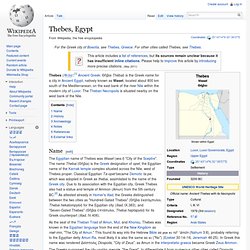
The Theban Necropolis is situated nearby on the west bank of the Nile. Name[edit] As the seat of the Theban Triad of Amun, Mut, and Khonsu, Thebes was known in the Egyptian language from the end of the New Kingdom as niwt-imn, "The City of Amun. " This found its way into the Hebrew Bible as נא אמון nōʼ ʼāmôn (Nahum 3:8), probably referring to the Egyptian deity Amun-Ra, most likely it is also the same as נא ("No") (Ezekiel 30:14–16, Jeremiah 46:25). In Greek this name was rendered Διόσπολις Diospolis, "City of Zeus", as Amun in the interpretatio graeca became Greek Zeus Ammon.
Djehuti. For the Ancient Egyptian god Djehuti, see Thoth.

Sobekhotep VIII. Neferhotep III. Sekhemre Sankhtawy Neferhotep III was the third or fourth ruler of the Theban 16th dynasty, reigning after Sobekhotep VIII according to egyptologists Kim Ryholt and Darell Baker.[1][2] He is assigned a reign of 1 year in the Turin Canon and is known primarily by a single stela from Thebes.[1] In an older study, Von Beckerath dated Neferhotep III to the end of the Thirteenth dynasty of Egypt.[3] Extent of rule[edit] In the stela (Cairo JE 59635[4]), Neferhotep III repeatedly calls Thebes "my city" and praises himself as "the guide of victorious Thebes".[5] This emphasis on Thebes is understood by Ryholt as showing that Neferhotep III reigned exclusively over the Theban region.

Reign[edit] Seankhenre Mentuhotepi. Nebiryraw I. Sewadjenre Nebiryraw or Nebiryerawet I was a pharaoh of Egypt of the 16th or 17th Theban dynasty based in Upper Egypt during the Second intermediate period.
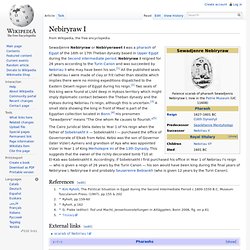
Nebiryraw I reigned for 26 years according to the Turin Canon and was succeeded by Nebiriau II who may have been his son.[1] All the published seals of Nebiriau I were made of clay or frit rather than steatite which implies there were no mining expeditions dispatched to the Eastern Desert region of Egypt during his reign.[2] Two seals of this king were found at Lisht deep in Hyksos territory which might imply diplomatic contact between the Theban dynasty and the Hyksos during Nebiriau I's reign, although this is uncertain.[3] A small stela showing the king in front of Maat is part of the Egyptian collection located in Bonn.[4] His prenomen "Sewadjenre" means "The One whom Re causes to flourish. Nebiriau II. Nebiriau II or Nebiryerawet was a king of the 16th or 17th Theban dynasty who ruled Upper Egypt during the Second Intermediate Period of Ancient Egypt.
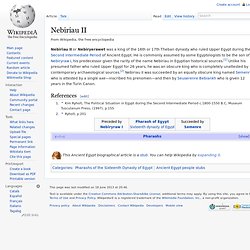
He is commonly assumed by some Egyptologists to be the son of Nebiryraw I, his predecessor given the rarity of the name Nebiriau in Egyptian historical sources.[1] Unlike his presumed father who ruled Upper Egypt for 26 years, he was an obscure king who is completely unattested by contemporary archaeological sources.[2] Nebiriau II was succeeded by an equally obscure king named Semenre who is attested by a single axe—inscribed his prenomen—and then by Seuserenre Bebiankh who is given 12 years in the Turin Canon. Jump up ^ Kim Ryholt, The Political Situation in Egypt during the Second Intermediate Period c.1800-1550 B.C, Museum Tusculanum Press, (1997), p.155Jump up ^ Ryholt, p.201. Semenre. Semenre is a poorly attested Theban king during the Second Intermediate Period of Egypt who succeeded the equally obscure Nebiriau II.
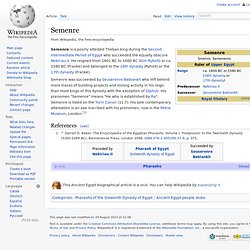
He reigned from 1601 BC to 1600 BC (Kim Ryholt) or ca. 1580 BC (Franke) and belonged to the 16th dynasty (Ryholt) or the 17th dynasty (Franke). Semenre was succeeded by Seuserenre Bebiankh who left behind more traces of building projects and mining activity in his reign than most kings of this dynasty with the exception of Djehuti. His prenomen "Semenre" means "He who is established by Ra". Semenre is listed on the Turin Canon (11.7).
His sole contemporary attestation is an axe inscribed with his prenomen, now in the Petrie Museum, London.[1] Jump up ^ Darrell D. Bebiankh. Seuserenre Bebiankh was a native Ancient Egyptian king of the 16th Theban dynasty during the Second Intermediate Period and the successor of king Semenre.

He is assigned a reign of 12 years in the Turin Canon (11.8).[1] Seuserenre is principally known by a stela found at Gebel Zeit that attests to mining activity conducted in this area by the Red Sea during his reign and preserves his royal nomen Bebiankh.[2] This modest stela records this king's activities in the Gebel Zeit galena mines.[3] He is also known to have built an extension to the Temple of Medamud.[4] Bebiankh's nomen was also found on a dagger found in Naqada and now in the British Museum, under the catalog number BM EA 66062.[1] Bebiankh was succeeded either by a poorly known king named Sekhemre Shedwast or by the equally shadowy ruler Seneferankhre Pepi III.[5] Sekhemre Shedwast. Sekhemre Shedwast (Sekhemreshedwaset) was a native Ancient Egyptian king of the 16th Theban dynasty during the Second Intermediate Period and the successor of king Bebiankh.[1] It has been suggested, but not currently accepted, that Sekhemre Shedwast may be identical to Sekhemre-shedtawi Sobekemsaf II--since their royal names differ.

If so, he may have been married to Queen Nubkhaes II and they may have had a son named Sekhemre-Wepmaat Intef.[2] Pepi III. Seneferankhre Pepi III may have been a pharaoh[2] of the Sixteenth dynasty of Egypt during the Second Intermediate Period.
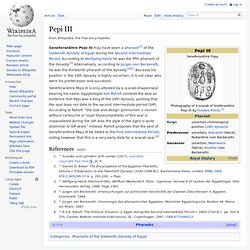
According to Wolfgang Helck he was the fifth pharaoh of the dynasty.[3] Alternatively, according to Jürgen von Beckerath, he was the thirteenth pharaoh of the dynasty.[4][5] Because his position in the 16th dynasty is highly uncertain, it is not clear who were his predecessor and successor. Seneferankhre Pepy III is only attested by a scarab-shaped seal bearing his name. Egyptologist Kim Ryholt contests the seal as evidence that Pepi was a king of the 16th dynasty, positing that the seal does not date to the second intermediate period (SIP). According to Ryholt: "the size and design (prenomen + nomen without cartouche or royal titulary/epithets) of this seal is unparalleled during the SIP. Also the style of the signs is quite dissimilar to SIP seals. "